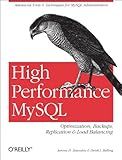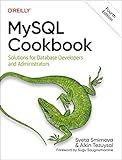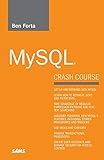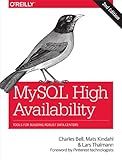Best Tools for MySQL Database Management to Buy in January 2026

High Performance MySQL: Optimization, Backups, Replication, Load Balancing & More (Advanced Tools and Techniques for MySQL Administrators)



MySQL Cookbook: Solutions for Database Developers and Administrators



SQL: Learn SQL (using MySQL) in One Day and Learn It Well. SQL for Beginners with Hands-on Project. (Learn Coding Fast with Hands-On Project Book 5)



MySQL Crash Course



MySQL High Availability: Tools for Building Robust Data Centers



Linux Server Hacks: 100 Industrial-Strength Tips and Tools
- QUALITY GUARANTEED: ALL USED BOOKS ARE INSPECTED FOR GOOD CONDITION.
- ECO-FRIENDLY CHOICE: SAVE MONEY AND REDUCE WASTE WITH EVERY PURCHASE.
- UNIQUE FINDS: DISCOVER RARE TITLES AND HIDDEN GEMS AT GREAT PRICES.



Head First PHP & MySQL: A Brain-Friendly Guide



Learning PHP, MySQL & JavaScript: With jQuery, CSS & HTML5 (Learning PHP, MYSQL, Javascript, CSS & HTML5)



Mastering MySQL: The Complete Guide to Database Management and Optimization: From Beginner to Advanced SQL Queries, Database Design, and Performance ... From Beginner to Full-Stack Mastery Book 5)


To update data in a MySQL table, you can use the UPDATE statement. This statement allows you to specify which columns you want to update and which values you want to set for those columns.
The basic syntax for the UPDATE statement is as follows:
UPDATE table_name SET column1 = value1, column2 = value2, ... WHERE condition;
In this syntax, table_name is the name of the table you want to update, column1, column2, etc. are the columns you want to update, value1, value2, etc. are the new values you want to set for those columns, and condition is the condition that identifies which rows in the table should be updated.
For example, if you want to update the "name" column in the "users" table to set the value to "John" for the row where the "id" column is equal to 1, you can use the following statement:
UPDATE users SET name = 'John' WHERE id = 1;
This will update the "name" column in the "users" table to "John" for the row where the "id" column is equal to 1.
You can also update multiple columns at once by separating them with commas in the SET clause. Additionally, you can use other clauses like ORDER BY and LIMIT to further refine the rows that you want to update.
What is the effect of updating data in a MySQL table on backups?
When data is updated in a MySQL table, the effect on backups depends on the type of backup being used:
- Full Backup: If a full backup is taken after the data has been updated, the updated data will be included in the backup. This ensures that the backup contains the most up-to-date information from the MySQL table.
- Incremental Backup: If an incremental backup is taken after the data has been updated, only the changes made since the last backup will be included in the backup. This means that the updated data will be captured in the incremental backup without having to backup the entire MySQL table again.
In both scenarios, it is important to ensure that backups are taken regularly and that they are stored securely in case of data loss or corruption. Additionally, it is recommended to test the backups periodically to ensure that they can be successfully restored in case of an emergency.
What is the significance of the WHERE clause when updating data in a MySQL table?
The WHERE clause is significant when updating data in a MySQL table because it allows you to specify which rows in the table should be updated. Without the WHERE clause, all the rows in the table would be affected by the update operation, which may not be the desired outcome. By using the WHERE clause, you can target specific rows based on certain conditions, such as specific values in a column, and update only those rows accordingly. This helps in ensuring that only the necessary rows are updated and helps in avoiding unintended changes to the entire table.
What is the role of indexes when updating data in a MySQL table?
Indexes play a crucial role when updating data in a MySQL table as they help speed up the update process by allowing the database to quickly locate the rows that need to be updated. When updating data in a table, MySQL uses indexes to efficiently locate the rows that match the update criteria, reducing the need to scan the entire table. This can significantly improve the performance of update operations, especially on large tables with a large number of rows.
In addition, indexes can also help ensure data integrity by enforcing constraints and uniqueness constraints when updating data. This helps prevent duplicate or incorrect data from being inserted into the table.
Overall, indexes play a key role in optimizing the performance and efficiency of update operations in a MySQL table.
What is the role of foreign keys when updating data in a MySQL table?
Foreign keys in MySQL enforce referential integrity between tables by ensuring that values in a column (or a set of columns) in one table match values in a primary key or unique key column in another table. When updating data in a MySQL table that has foreign keys, the foreign key constraints will need to be taken into account to avoid any data inconsistencies or violations.
When updating data in a MySQL table with foreign keys, the following considerations should be made:
- The updated data in the column(s) referenced by the foreign key should match the values in the primary key or unique key column of the related table. If the updated data does not match, the update operation will fail and an error will be thrown.
- If the update operation affects the foreign key column(s) in a way that violates the referential integrity constraint, such as deleting a record that is being referenced by another table, the update will fail to prevent orphaned records or broken relationships.
- In some cases, updating the primary key or unique key column in a related table may require cascading updates to the foreign key columns in other tables. This can be achieved through cascading referential actions, such as ON UPDATE CASCADE, which automatically updates the values in the referencing foreign key columns.
In summary, foreign keys play a crucial role in ensuring data consistency and maintaining the integrity of relationships between tables in a MySQL database. When updating data in a table with foreign keys, these constraints must be considered to prevent violations and maintain the integrity of the database.
How to update data in a MySQL table from a JSON file?
You can update data in a MySQL table from a JSON file using the following steps:
- Read the JSON file and parse it to extract the data you want to update in the database.
- Connect to your MySQL database using a MySQL client or a programming language such as Python, PHP, or Node.js.
- Construct an UPDATE query that updates the specific rows in the table with the data from the JSON file.
- Execute the UPDATE query to update the records in the database.
Here is an example in Python using the pymysql library to update data in a MySQL table from a JSON file:
import json import pymysql
Load JSON data from file
with open('data.json') as f: data = json.load(f)
Connect to MySQL database
connection = pymysql.connect(host='localhost', user='username', password='password', database='database') cursor = connection.cursor()
Update data in the table
for record in data: sql = "UPDATE table SET column1 = %s, column2 = %s WHERE id = %s" cursor.execute(sql, (record['value1'], record['value2'], record['id']))
Commit the changes
connection.commit()
Close the connection
connection.close()
Replace 'data.json' with the path to your JSON file, 'table' with the name of your MySQL table, and 'column1', 'column2', and 'id' with the columns you want to update. Adjust the query and data extraction logic as needed for your specific use case.
